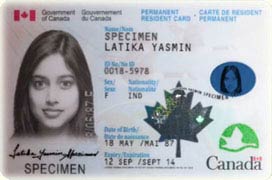Since you have been working in Canada for several years with your temporary work permit, you may want to apply for permanent residence in Canada. If you don’t know how to convert a work permit to PR in Canada, you can read this article below and complete the process to change your work permit to permanent resident in Canada.
Canada Work Permit vs. Canada PR
Before applying for a Canada PR, it is best to know the difference between a Canada work permit and a Canada permanent residence permit. A Canadian work permit is a type of visa that allows you to work or live in Canada for a certain period of 4 years. And the Canadian work permit is about your employer and your job. When you have a Canadian permanent residence, you can live, work, and study in Canada indefinitely. You can enjoy many benefits, such as health care, social services, and the opportunity to acquire Canadian citizenship. The process of changing from a work permit to a Canadian PR can be challenging, so you can follow the steps below to complete the transition.

📢Read Also: How to Convert Canada Vistor Visa to Work Permit in 2024
How to Convert Work Permit to PR in Canada
When you need to change your Canada work permit to PR, you can obtain your Canadian PR by following the steps below and choosing the appropriate Canadian immigration programs.
Check Eligibility
You must check your eligibility in advance before transferring a work permit to Canada PR. Because there are different requirements for Canada’s permanent residency programs, you need to know whether you are eligible for the program or not. There is a point-based system, the Comprehensive Ranking System (CRS), and it will take all the factors into account, such as your age, education, work experience, and language ability.

Choose a Suitable PR program
You can choose the most appropriate Canada PR program to get more PR opportunities in Canada. Each has its own requirements, so you should know them well.
- Canadian Experience Class (CEC)
The Canadian Experience Class (CEC) is one of the pathways to permanent residence in Canada. It is for skilled workers with Canadian work experience, which is in the National Occupational Classification (NOC) skill level 0 (managerial occupations), skill level A (professional occupations), or skill level B (technical and skilled trades) occupation. You need to prove your proficiency in English or French, such as IELTS or TEF. And you must create an Express Entry profile. Of course, if you want to improve your CEC scores, you can obtain a valid job offer, contribute to your educational qualifications and gain more work experience relevant to the program guidelines.
- Federal Skilled Worker Program (FSWP)
If you are temporarily employed by a Canadian firm and are offered permanent employment, you can apply for permanent residence under the Federal Skilled Worker Program. You must have at least two years of full-time work experience acquired as a result of certification in the last five years. You must have at least a Canadian secondary (high school) or post-secondary certificate, diploma, or degree. And you must show your language proficiency in either English or French with an approved language test. In addition, you must make an Express Entry profile and enter the Express Entry pool.

- Provincial Nominee Program (PNP)
The Provincial Nominee Program provides an opportunity for applicants to obtain permanent residency, allowing Canadian provinces to nominate applicants who wish to immigrate to Canada and live in a particular province. And each province and territory has its own unique PNP requirements and will consider the applicant’s contribution to the specific province’s economy, such as age, education, work experience, and language proficiency. And territories include Alberta, British Columbia, Manitoba, etc. Interested applicants should consult each province to determine their eligibility. Most PNPs have different streams or categories, such as skilled workers, investors, and semi-skilled workers.
- Quebec Experience Class (QEC)
If you work or study in Quebec, you can apply for PR with the Quebec Experience Class (QEC), which is a fast-track immigration program to help applicants complete the application within 6 months. And applicants need to get the full-time work experience at NOC TEER 0, 1, 2, or 3 and offer the proficiency of French ability, such as the Test de connaissance du français pour le Québec (TCF-Québec) or the Test d’évaluation du français adapté pour le Québec (TEFAQ). If you want the QEC program, you must submit an Expression of Interest (EOI) through the Arrima platform.
- Family Sponsorship
If you have a Canadian citizen or permanent resident spouse, common-law partner, or children, you can try the Family Sponsorship Program. It is a pathway for certain family members to become permanent residents of Canada, so they can live, study, and work in Canada. Sponsor must be 18 years old and meet certain income requirements. In addition, the program will include the following streams: sponsoring a spouse, partner, dependent children, parents, grandparents and other relatives. When you apply for this program, the process time will be shorter than others.
Create an application
After you have selected the right program, you can create your application now. There are many options for you to build your application, such as online, by mail or at a visa center. You are required to fill out different forms based on the chosen program. And you need to edit your application form by adding or changing job types, dependencies, and requirements. You must follow the program’s guidelines.

Collect required documents and pay fees
After you have created your application, you must collect supporting documents to complete your Canada PR application. Documents will change depending on your chosen program. Basically, they contain proof of work experience, proof of language tests, proof of age, educational credentials, and police clearance certificates. In addition, you are required to pay application fees that vary depending on the Canada PR program you are applying for.
Submit application
After you have collected all the documents and paid the application fees, you can submit your application now. And you should recheck your application before submitting it to ensure all the information is complete and correct. If you don’t submit the supporting documents at one time, it will delay your application. Then you can wait for the decision to get your permanent residency.
Convert to PR with a Special Stream
If you want to convert temporary work permits to PR, you can use normal streams such as Canadian Experience Class (CEC), Provincial Nominee Program (PNP), Family Sponsorship, Federal Skilled Worker Program (FSWP) and Quebec Experience Class (QEC). Other special streams such as the Essential Worker Stream and Healthcare Worker Stream have been shut down at the moment.
How Long Does a Canadian Work Permit to PR Take?
This process of changing Canadian work permits to PR will depend on your application and the volume of applications. It can usually take up to 12-18 months. For example, if you change your temporary work permit to permanent residence through QEC, it can take at least one year.
FAQ
How can I stay in Canada after my work permit expires?
If your work permit expires and you want to stay in Canada longer, you can try several options below to extend your stay in Canada. You can ask your employer to send you a work permit through the Temporary Foreign Worker Program or the International Mobility Program. You can apply for permanent residence using the above pathways. Or you can go back to being a tourist, but you can’t work in Canada. Of course, you can enter IEC a second time through your country’s Youth Mobility Agreement with Canada.
What is the difference between closed work permits and open work permits?
When applying for permanent residence, you must submit an open work permit. An open work permit allows holders to work in any position for any employer in Canada for the duration of the work permit. However, if you have a closed work permit, you can only work for a specific employer in a specific position for a specific period of time.
Can I apply for a PR with a closed work permit?
Yes. You can apply for PR with your closed work permit. However, you must meet other requirements to obtain permanent residence. There is no guarantee of permanent residence when you only have a closed work permit.:
Can I convert lMIA to PR?
No. A Labour Market Impact Assessment (LMIA) is a tool that can boost your chances of becoming a permanent resident in Canada. When you want to apply for PR with the Federal Skilled Immigration Stream or Provincial Nominee Skilled Worker Stream, a positive LMIA can increase your chances.
Conclusion
All in all, since you have met all the requirements and chosen the most suitable route, it is still possible to change your work permit to permanent residency in Canada. You must prepare all supporting documents to ensure that your application will not be rejected because of missing documents. I hope you have a smooth PR application process.